Exploring International Intellectual Property Law and its Impact
VerifiedAdded on 2022/12/28
|18
|4244
|4
Report
AI Summary
This report provides a comprehensive overview of international intellectual property law, focusing on the protection of intangible assets such as patents, trademarks, designs, and trade secrets. It examines the role of the European Union in standardizing intellectual property rights, highlighting the functions of the European Patent Office and the impact of international agreements like the Berne Convention. The report also delves into the TRIPS Agreement, outlining its standards, enforcement mechanisms, and dispute settlement processes. Furthermore, it explores the interplay between competition law and intellectual property, discussing landmark cases like Huawei v ZET. The relationship between intellectual property rights and property law is analyzed, emphasizing the protection of unique cultural, business, and philosophical creations. The report also touches upon limitations and exceptions to copyright, referencing cases like Nokia v HTC and Deutsche Grammophon v. Metro, and concludes with a discussion of the Treaty on the Functioning of the European Union and the principles applied by the Court of Justice in relation to the free movement of goods within the internal market.
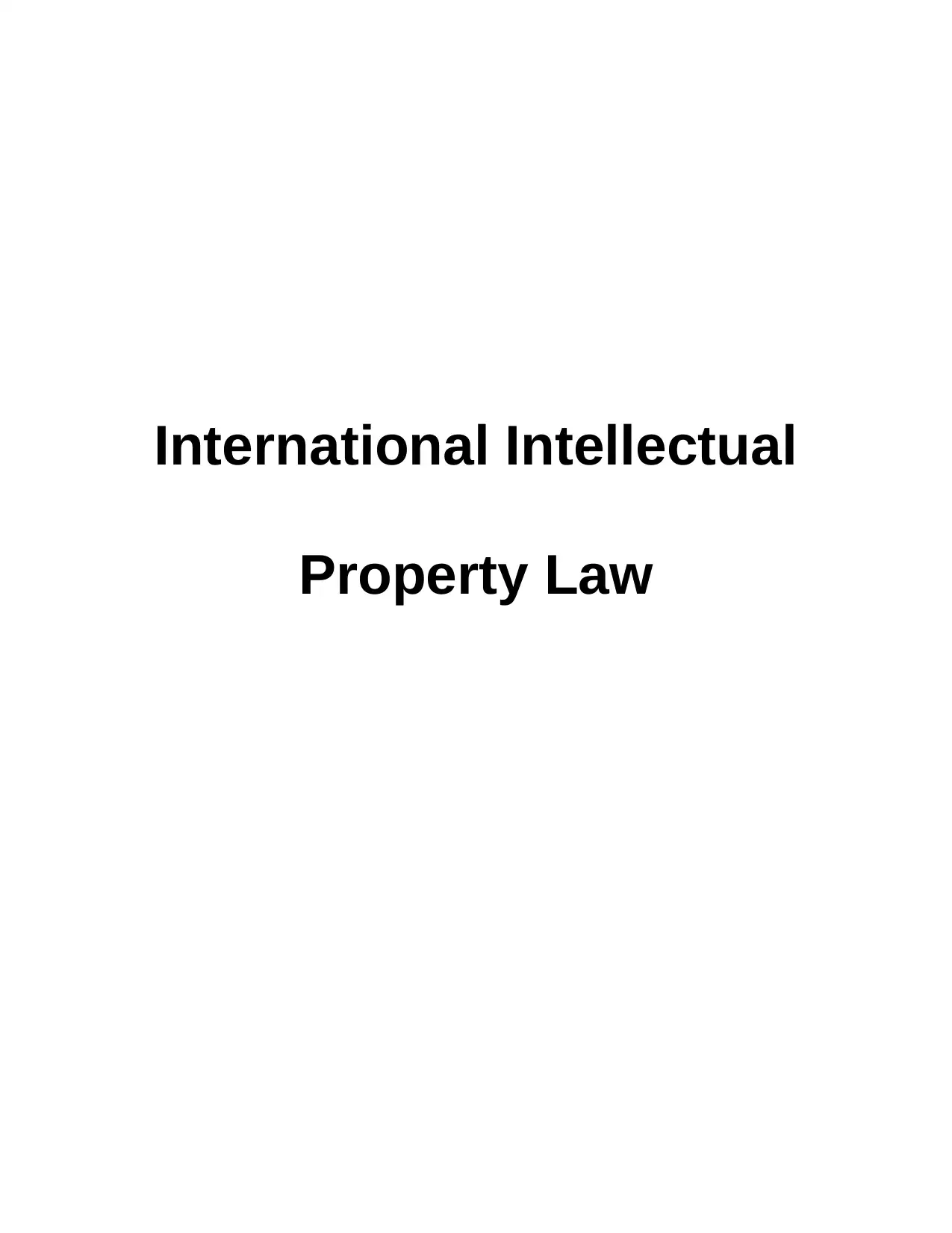
International Intellectual
Property Law
Property Law
Paraphrase This Document
Need a fresh take? Get an instant paraphrase of this document with our AI Paraphraser
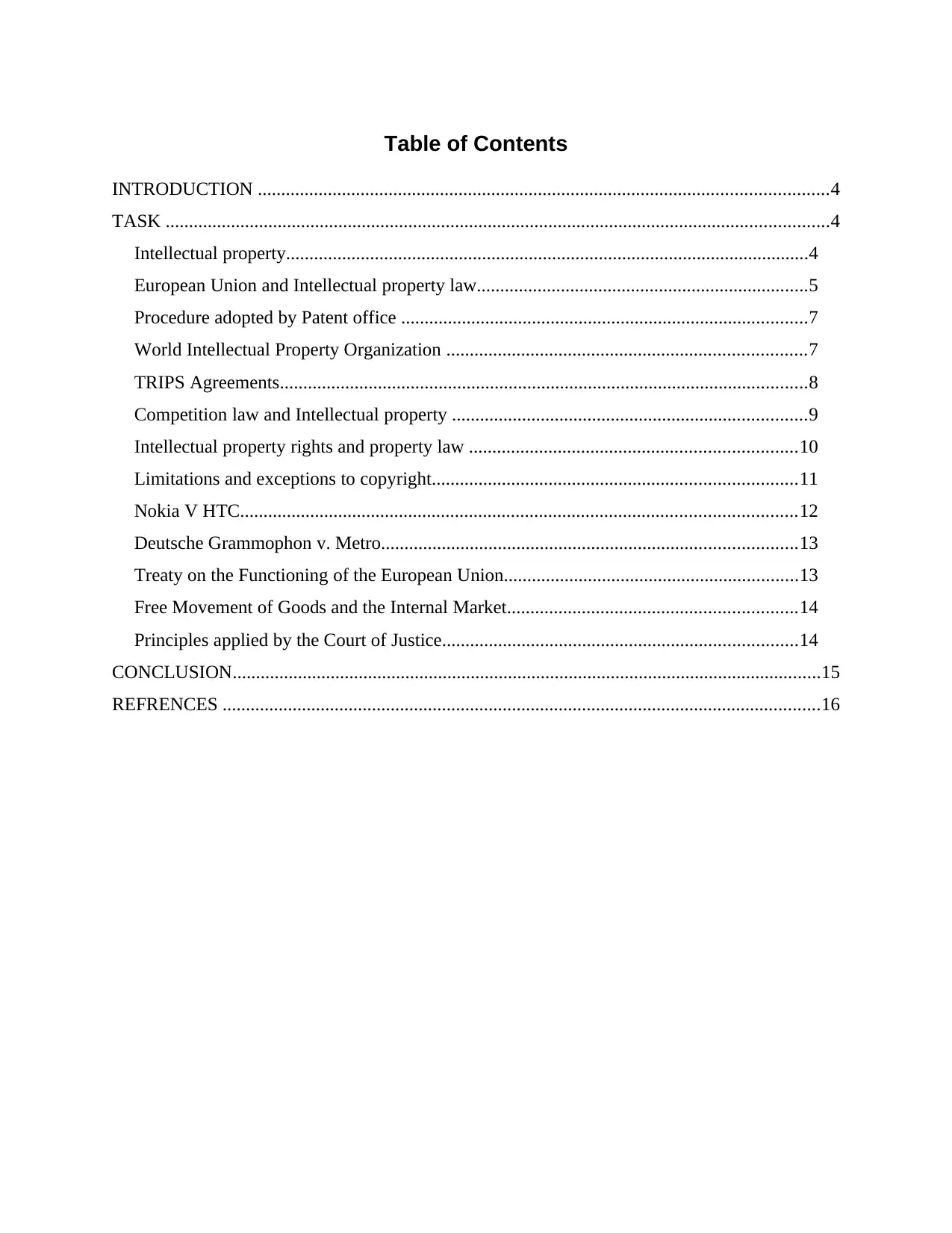
Table of Contents
INTRODUCTION ..........................................................................................................................4
TASK ..............................................................................................................................................4
Intellectual property................................................................................................................4
European Union and Intellectual property law.......................................................................5
Procedure adopted by Patent office .......................................................................................7
World Intellectual Property Organization .............................................................................7
TRIPS Agreements.................................................................................................................8
Competition law and Intellectual property ............................................................................9
Intellectual property rights and property law ......................................................................10
Limitations and exceptions to copyright..............................................................................11
Nokia V HTC.......................................................................................................................12
Deutsche Grammophon v. Metro.........................................................................................13
Treaty on the Functioning of the European Union...............................................................13
Free Movement of Goods and the Internal Market..............................................................14
Principles applied by the Court of Justice............................................................................14
CONCLUSION..............................................................................................................................15
REFRENCES ................................................................................................................................16
INTRODUCTION ..........................................................................................................................4
TASK ..............................................................................................................................................4
Intellectual property................................................................................................................4
European Union and Intellectual property law.......................................................................5
Procedure adopted by Patent office .......................................................................................7
World Intellectual Property Organization .............................................................................7
TRIPS Agreements.................................................................................................................8
Competition law and Intellectual property ............................................................................9
Intellectual property rights and property law ......................................................................10
Limitations and exceptions to copyright..............................................................................11
Nokia V HTC.......................................................................................................................12
Deutsche Grammophon v. Metro.........................................................................................13
Treaty on the Functioning of the European Union...............................................................13
Free Movement of Goods and the Internal Market..............................................................14
Principles applied by the Court of Justice............................................................................14
CONCLUSION..............................................................................................................................15
REFRENCES ................................................................................................................................16
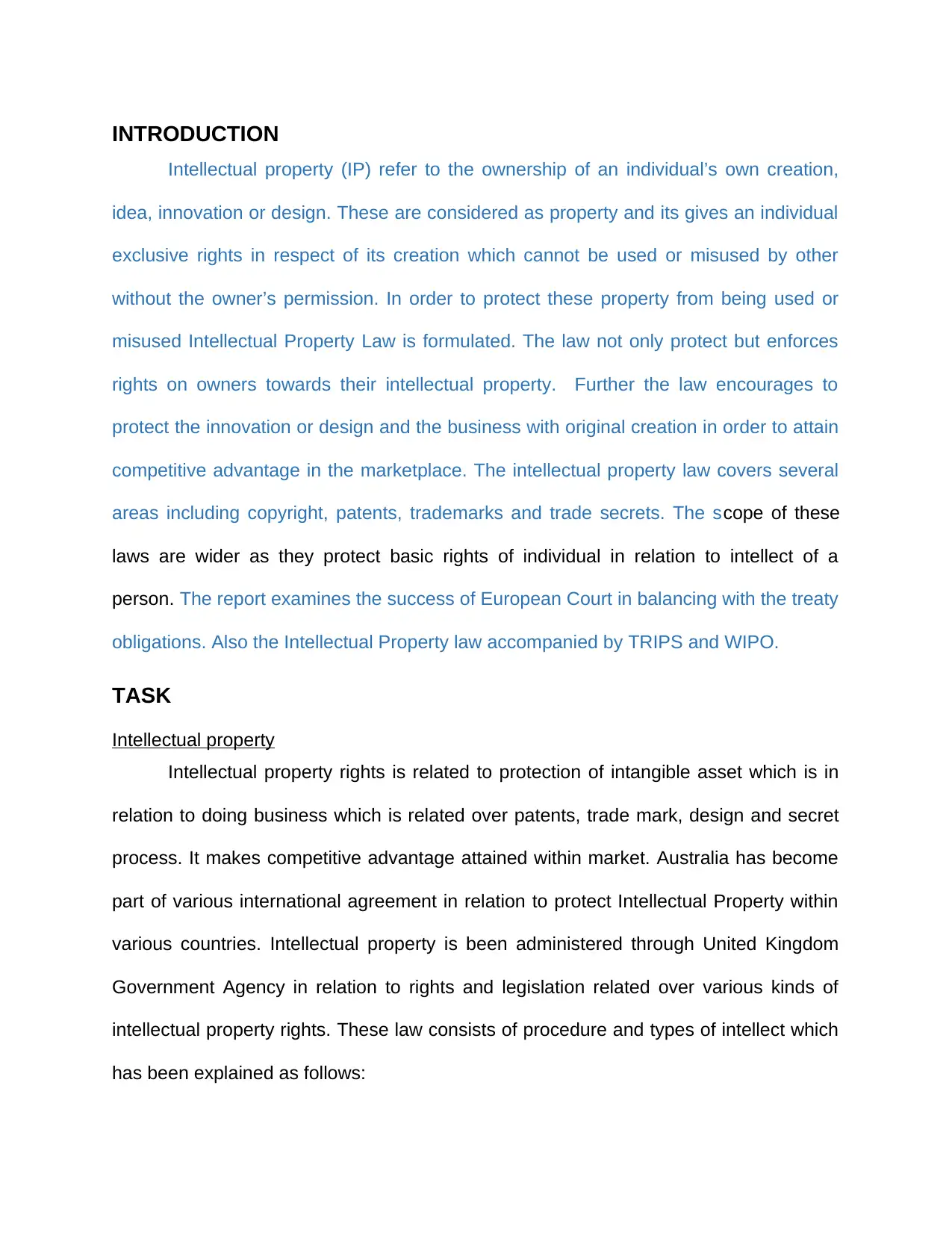
INTRODUCTION
Intellectual property (IP) refer to the ownership of an individual’s own creation,
idea, innovation or design. These are considered as property and its gives an individual
exclusive rights in respect of its creation which cannot be used or misused by other
without the owner’s permission. In order to protect these property from being used or
misused Intellectual Property Law is formulated. The law not only protect but enforces
rights on owners towards their intellectual property. Further the law encourages to
protect the innovation or design and the business with original creation in order to attain
competitive advantage in the marketplace. The intellectual property law covers several
areas including copyright, patents, trademarks and trade secrets. The scope of these
laws are wider as they protect basic rights of individual in relation to intellect of a
person. The report examines the success of European Court in balancing with the treaty
obligations. Also the Intellectual Property law accompanied by TRIPS and WIPO.
TASK
Intellectual property
Intellectual property rights is related to protection of intangible asset which is in
relation to doing business which is related over patents, trade mark, design and secret
process. It makes competitive advantage attained within market. Australia has become
part of various international agreement in relation to protect Intellectual Property within
various countries. Intellectual property is been administered through United Kingdom
Government Agency in relation to rights and legislation related over various kinds of
intellectual property rights. These law consists of procedure and types of intellect which
has been explained as follows:
Intellectual property (IP) refer to the ownership of an individual’s own creation,
idea, innovation or design. These are considered as property and its gives an individual
exclusive rights in respect of its creation which cannot be used or misused by other
without the owner’s permission. In order to protect these property from being used or
misused Intellectual Property Law is formulated. The law not only protect but enforces
rights on owners towards their intellectual property. Further the law encourages to
protect the innovation or design and the business with original creation in order to attain
competitive advantage in the marketplace. The intellectual property law covers several
areas including copyright, patents, trademarks and trade secrets. The scope of these
laws are wider as they protect basic rights of individual in relation to intellect of a
person. The report examines the success of European Court in balancing with the treaty
obligations. Also the Intellectual Property law accompanied by TRIPS and WIPO.
TASK
Intellectual property
Intellectual property rights is related to protection of intangible asset which is in
relation to doing business which is related over patents, trade mark, design and secret
process. It makes competitive advantage attained within market. Australia has become
part of various international agreement in relation to protect Intellectual Property within
various countries. Intellectual property is been administered through United Kingdom
Government Agency in relation to rights and legislation related over various kinds of
intellectual property rights. These law consists of procedure and types of intellect which
has been explained as follows:
⊘ This is a preview!⊘
Do you want full access?
Subscribe today to unlock all pages.

Trusted by 1+ million students worldwide
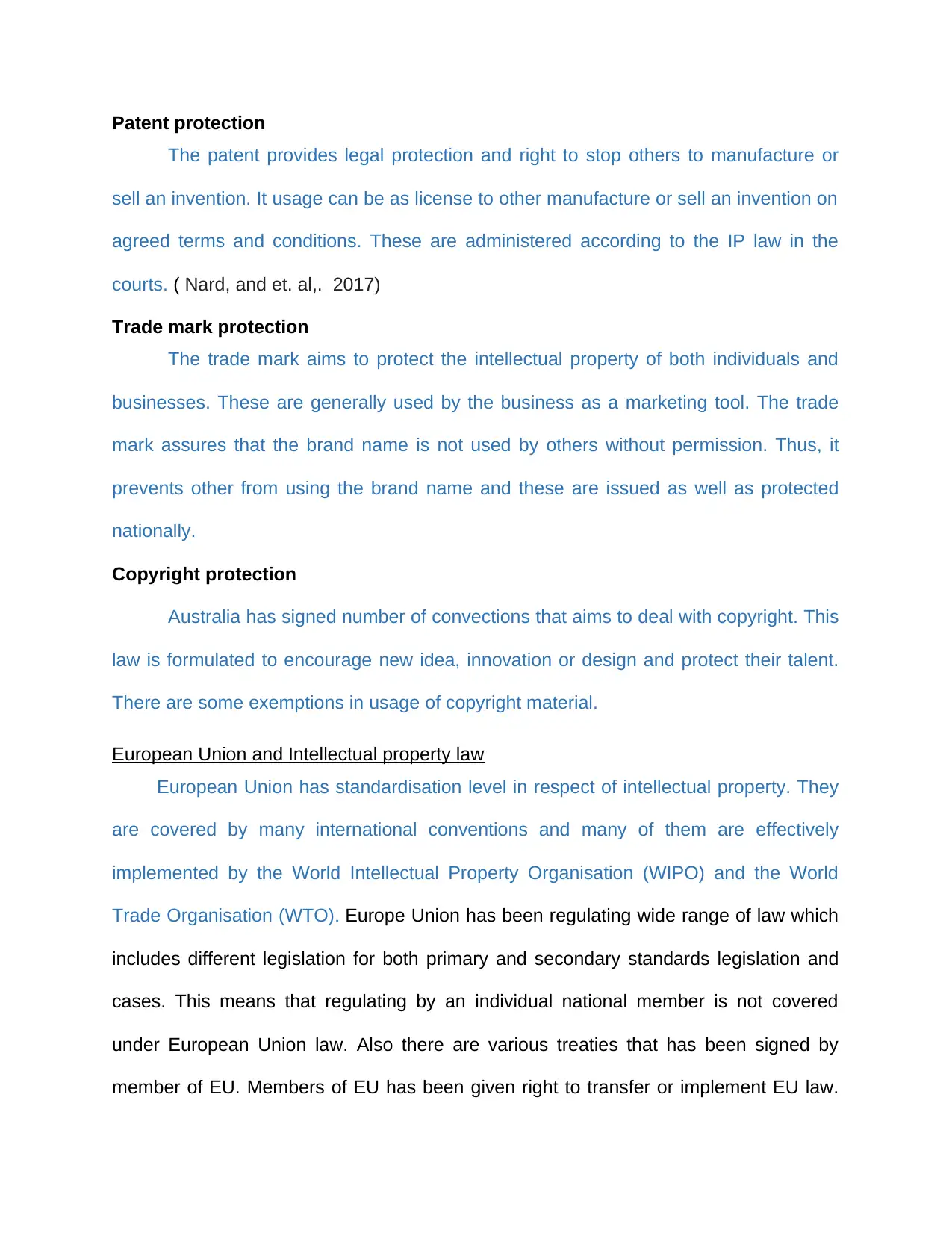
Patent protection
The patent provides legal protection and right to stop others to manufacture or
sell an invention. It usage can be as license to other manufacture or sell an invention on
agreed terms and conditions. These are administered according to the IP law in the
courts. ( Nard, and et. al,. 2017)
Trade mark protection
The trade mark aims to protect the intellectual property of both individuals and
businesses. These are generally used by the business as a marketing tool. The trade
mark assures that the brand name is not used by others without permission. Thus, it
prevents other from using the brand name and these are issued as well as protected
nationally.
Copyright protection
Australia has signed number of convections that aims to deal with copyright. This
law is formulated to encourage new idea, innovation or design and protect their talent.
There are some exemptions in usage of copyright material.
European Union and Intellectual property law
European Union has standardisation level in respect of intellectual property. They
are covered by many international conventions and many of them are effectively
implemented by the World Intellectual Property Organisation (WIPO) and the World
Trade Organisation (WTO). Europe Union has been regulating wide range of law which
includes different legislation for both primary and secondary standards legislation and
cases. This means that regulating by an individual national member is not covered
under European Union law. Also there are various treaties that has been signed by
member of EU. Members of EU has been given right to transfer or implement EU law.
The patent provides legal protection and right to stop others to manufacture or
sell an invention. It usage can be as license to other manufacture or sell an invention on
agreed terms and conditions. These are administered according to the IP law in the
courts. ( Nard, and et. al,. 2017)
Trade mark protection
The trade mark aims to protect the intellectual property of both individuals and
businesses. These are generally used by the business as a marketing tool. The trade
mark assures that the brand name is not used by others without permission. Thus, it
prevents other from using the brand name and these are issued as well as protected
nationally.
Copyright protection
Australia has signed number of convections that aims to deal with copyright. This
law is formulated to encourage new idea, innovation or design and protect their talent.
There are some exemptions in usage of copyright material.
European Union and Intellectual property law
European Union has standardisation level in respect of intellectual property. They
are covered by many international conventions and many of them are effectively
implemented by the World Intellectual Property Organisation (WIPO) and the World
Trade Organisation (WTO). Europe Union has been regulating wide range of law which
includes different legislation for both primary and secondary standards legislation and
cases. This means that regulating by an individual national member is not covered
under European Union law. Also there are various treaties that has been signed by
member of EU. Members of EU has been given right to transfer or implement EU law.
Paraphrase This Document
Need a fresh take? Get an instant paraphrase of this document with our AI Paraphraser
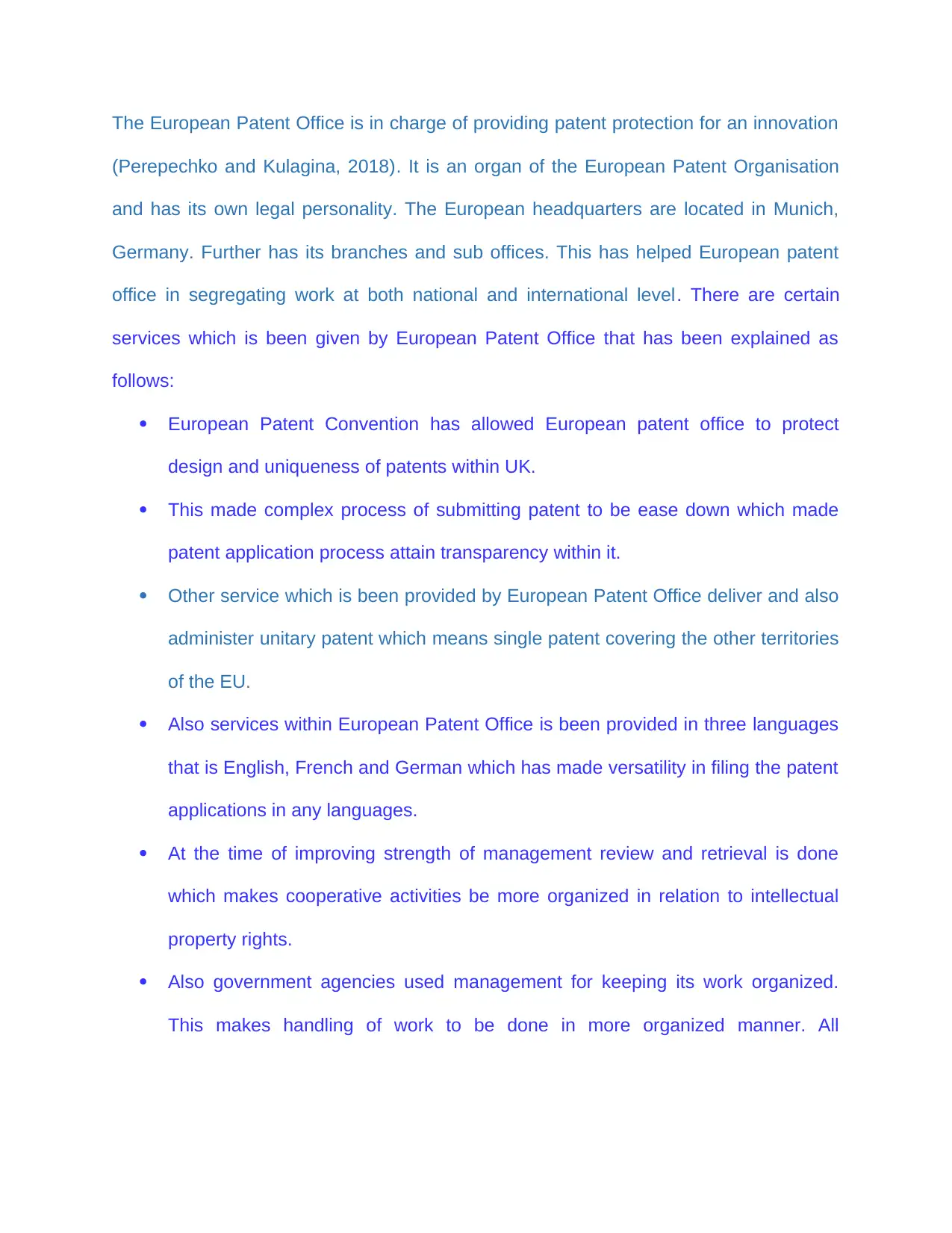
The European Patent Office is in charge of providing patent protection for an innovation
(Perepechko and Kulagina, 2018). It is an organ of the European Patent Organisation
and has its own legal personality. The European headquarters are located in Munich,
Germany. Further has its branches and sub offices. This has helped European patent
office in segregating work at both national and international level. There are certain
services which is been given by European Patent Office that has been explained as
follows:
European Patent Convention has allowed European patent office to protect
design and uniqueness of patents within UK.
This made complex process of submitting patent to be ease down which made
patent application process attain transparency within it.
Other service which is been provided by European Patent Office deliver and also
administer unitary patent which means single patent covering the other territories
of the EU.
Also services within European Patent Office is been provided in three languages
that is English, French and German which has made versatility in filing the patent
applications in any languages.
At the time of improving strength of management review and retrieval is done
which makes cooperative activities be more organized in relation to intellectual
property rights.
Also government agencies used management for keeping its work organized.
This makes handling of work to be done in more organized manner. All
(Perepechko and Kulagina, 2018). It is an organ of the European Patent Organisation
and has its own legal personality. The European headquarters are located in Munich,
Germany. Further has its branches and sub offices. This has helped European patent
office in segregating work at both national and international level. There are certain
services which is been given by European Patent Office that has been explained as
follows:
European Patent Convention has allowed European patent office to protect
design and uniqueness of patents within UK.
This made complex process of submitting patent to be ease down which made
patent application process attain transparency within it.
Other service which is been provided by European Patent Office deliver and also
administer unitary patent which means single patent covering the other territories
of the EU.
Also services within European Patent Office is been provided in three languages
that is English, French and German which has made versatility in filing the patent
applications in any languages.
At the time of improving strength of management review and retrieval is done
which makes cooperative activities be more organized in relation to intellectual
property rights.
Also government agencies used management for keeping its work organized.
This makes handling of work to be done in more organized manner. All
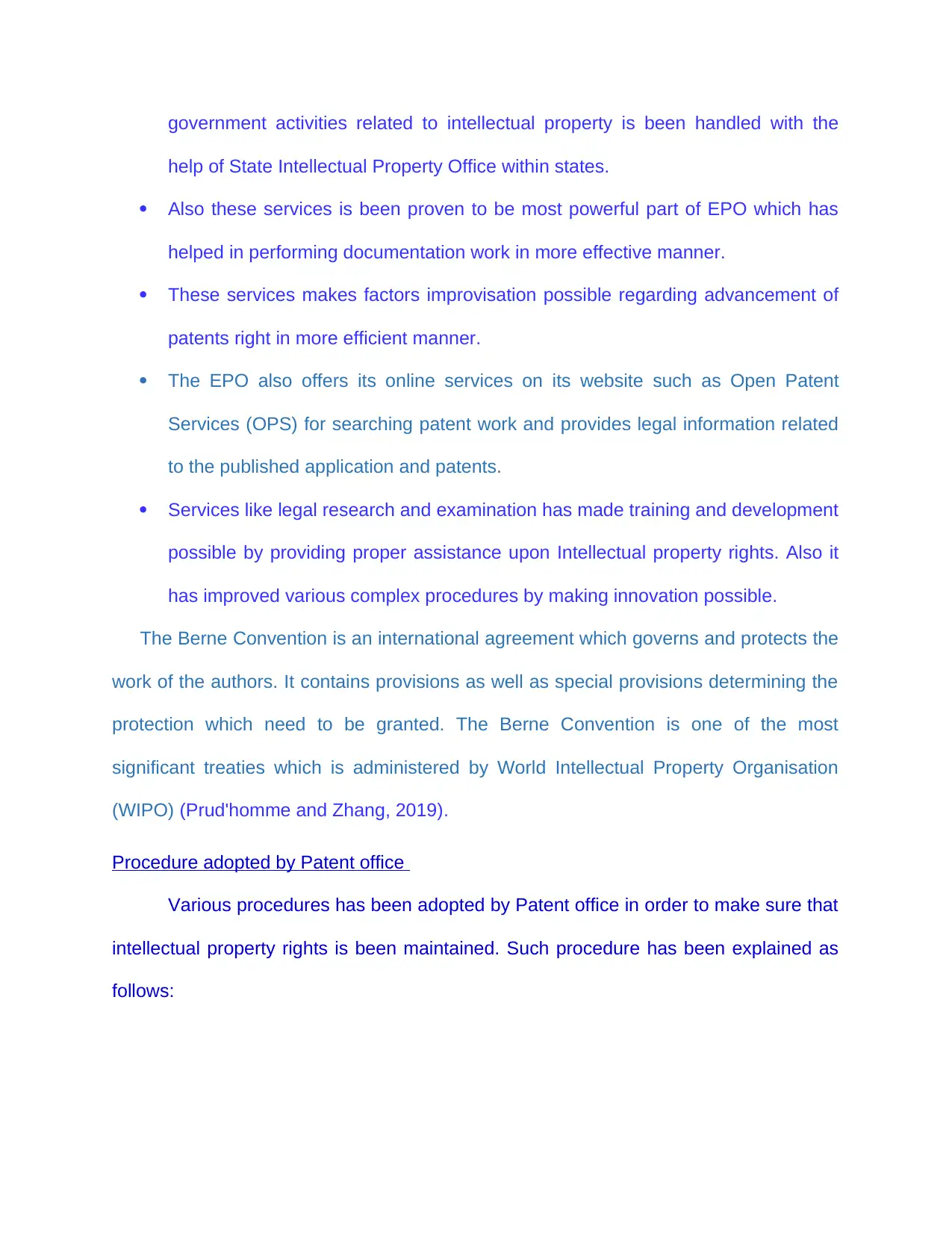
government activities related to intellectual property is been handled with the
help of State Intellectual Property Office within states.
Also these services is been proven to be most powerful part of EPO which has
helped in performing documentation work in more effective manner.
These services makes factors improvisation possible regarding advancement of
patents right in more efficient manner.
The EPO also offers its online services on its website such as Open Patent
Services (OPS) for searching patent work and provides legal information related
to the published application and patents.
Services like legal research and examination has made training and development
possible by providing proper assistance upon Intellectual property rights. Also it
has improved various complex procedures by making innovation possible.
The Berne Convention is an international agreement which governs and protects the
work of the authors. It contains provisions as well as special provisions determining the
protection which need to be granted. The Berne Convention is one of the most
significant treaties which is administered by World Intellectual Property Organisation
(WIPO) (Prud'homme and Zhang, 2019).
Procedure adopted by Patent office
Various procedures has been adopted by Patent office in order to make sure that
intellectual property rights is been maintained. Such procedure has been explained as
follows:
help of State Intellectual Property Office within states.
Also these services is been proven to be most powerful part of EPO which has
helped in performing documentation work in more effective manner.
These services makes factors improvisation possible regarding advancement of
patents right in more efficient manner.
The EPO also offers its online services on its website such as Open Patent
Services (OPS) for searching patent work and provides legal information related
to the published application and patents.
Services like legal research and examination has made training and development
possible by providing proper assistance upon Intellectual property rights. Also it
has improved various complex procedures by making innovation possible.
The Berne Convention is an international agreement which governs and protects the
work of the authors. It contains provisions as well as special provisions determining the
protection which need to be granted. The Berne Convention is one of the most
significant treaties which is administered by World Intellectual Property Organisation
(WIPO) (Prud'homme and Zhang, 2019).
Procedure adopted by Patent office
Various procedures has been adopted by Patent office in order to make sure that
intellectual property rights is been maintained. Such procedure has been explained as
follows:
⊘ This is a preview!⊘
Do you want full access?
Subscribe today to unlock all pages.

Trusted by 1+ million students worldwide
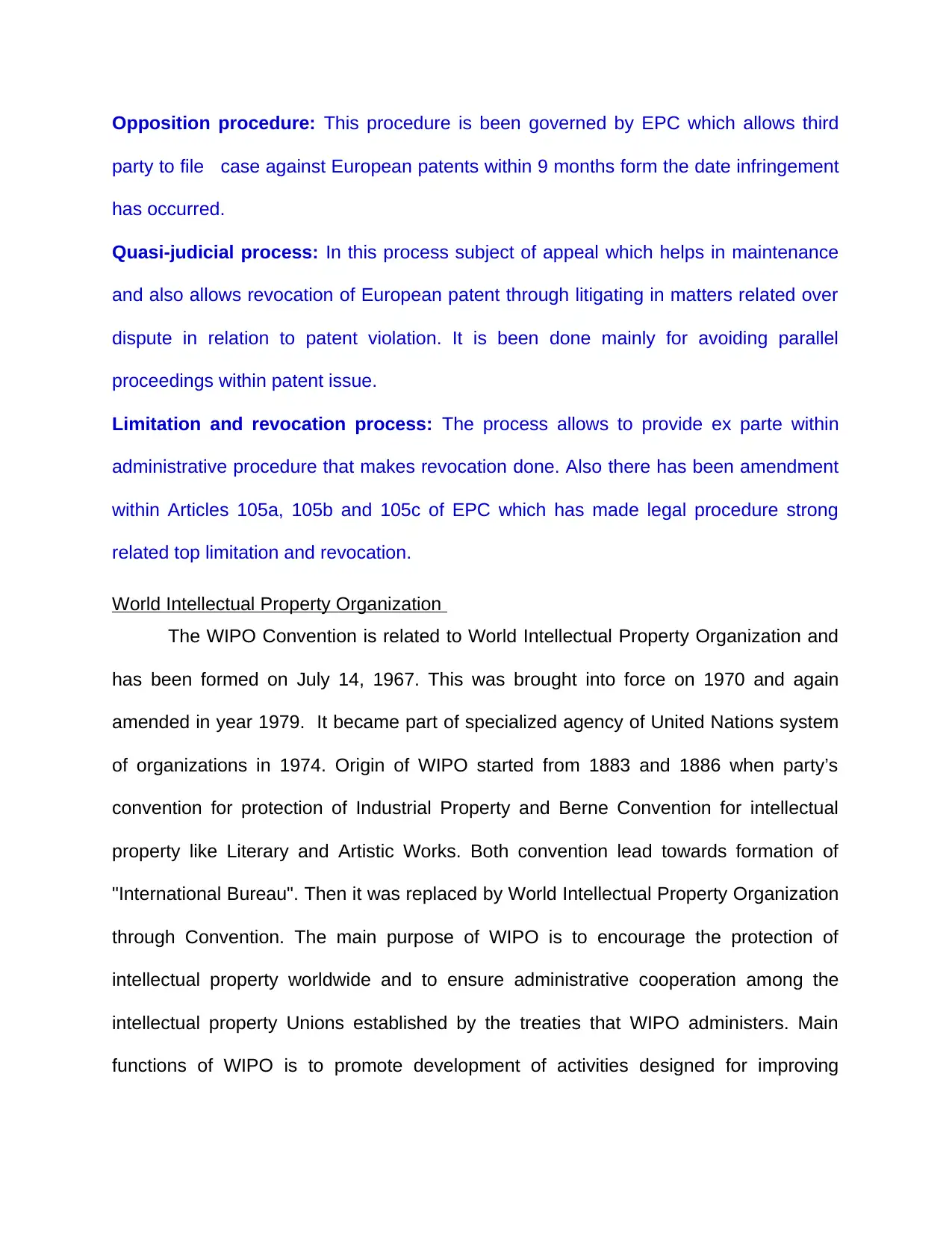
Opposition procedure: This procedure is been governed by EPC which allows third
party to file case against European patents within 9 months form the date infringement
has occurred.
Quasi-judicial process: In this process subject of appeal which helps in maintenance
and also allows revocation of European patent through litigating in matters related over
dispute in relation to patent violation. It is been done mainly for avoiding parallel
proceedings within patent issue.
Limitation and revocation process: The process allows to provide ex parte within
administrative procedure that makes revocation done. Also there has been amendment
within Articles 105a, 105b and 105c of EPC which has made legal procedure strong
related top limitation and revocation.
World Intellectual Property Organization
The WIPO Convention is related to World Intellectual Property Organization and
has been formed on July 14, 1967. This was brought into force on 1970 and again
amended in year 1979. It became part of specialized agency of United Nations system
of organizations in 1974. Origin of WIPO started from 1883 and 1886 when party’s
convention for protection of Industrial Property and Berne Convention for intellectual
property like Literary and Artistic Works. Both convention lead towards formation of
"International Bureau". Then it was replaced by World Intellectual Property Organization
through Convention. The main purpose of WIPO is to encourage the protection of
intellectual property worldwide and to ensure administrative cooperation among the
intellectual property Unions established by the treaties that WIPO administers. Main
functions of WIPO is to promote development of activities designed for improving
party to file case against European patents within 9 months form the date infringement
has occurred.
Quasi-judicial process: In this process subject of appeal which helps in maintenance
and also allows revocation of European patent through litigating in matters related over
dispute in relation to patent violation. It is been done mainly for avoiding parallel
proceedings within patent issue.
Limitation and revocation process: The process allows to provide ex parte within
administrative procedure that makes revocation done. Also there has been amendment
within Articles 105a, 105b and 105c of EPC which has made legal procedure strong
related top limitation and revocation.
World Intellectual Property Organization
The WIPO Convention is related to World Intellectual Property Organization and
has been formed on July 14, 1967. This was brought into force on 1970 and again
amended in year 1979. It became part of specialized agency of United Nations system
of organizations in 1974. Origin of WIPO started from 1883 and 1886 when party’s
convention for protection of Industrial Property and Berne Convention for intellectual
property like Literary and Artistic Works. Both convention lead towards formation of
"International Bureau". Then it was replaced by World Intellectual Property Organization
through Convention. The main purpose of WIPO is to encourage the protection of
intellectual property worldwide and to ensure administrative cooperation among the
intellectual property Unions established by the treaties that WIPO administers. Main
functions of WIPO is to promote development of activities designed for improving
Paraphrase This Document
Need a fresh take? Get an instant paraphrase of this document with our AI Paraphraser
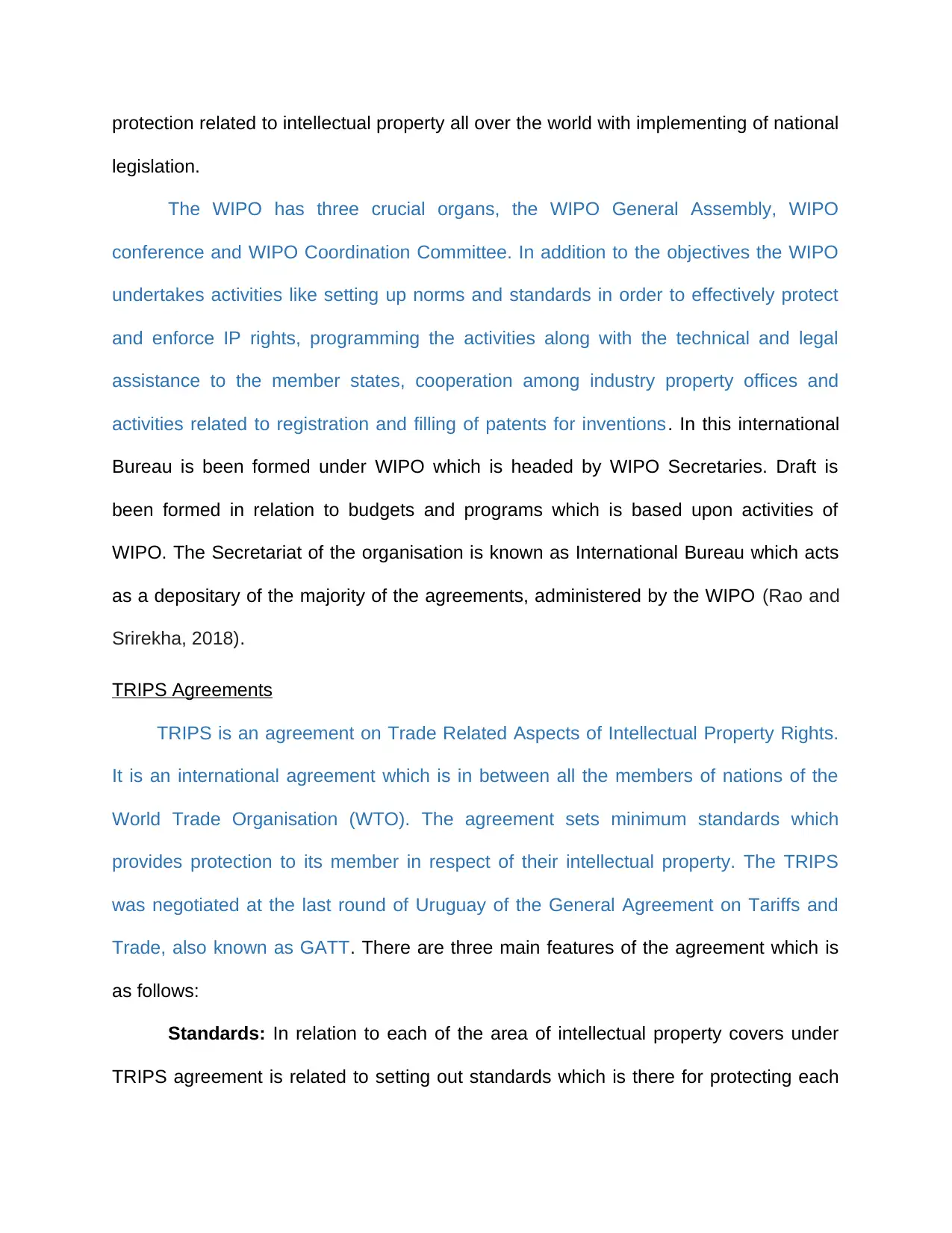
protection related to intellectual property all over the world with implementing of national
legislation.
The WIPO has three crucial organs, the WIPO General Assembly, WIPO
conference and WIPO Coordination Committee. In addition to the objectives the WIPO
undertakes activities like setting up norms and standards in order to effectively protect
and enforce IP rights, programming the activities along with the technical and legal
assistance to the member states, cooperation among industry property offices and
activities related to registration and filling of patents for inventions. In this international
Bureau is been formed under WIPO which is headed by WIPO Secretaries. Draft is
been formed in relation to budgets and programs which is based upon activities of
WIPO. The Secretariat of the organisation is known as International Bureau which acts
as a depositary of the majority of the agreements, administered by the WIPO (Rao and
Srirekha, 2018).
TRIPS Agreements
TRIPS is an agreement on Trade Related Aspects of Intellectual Property Rights.
It is an international agreement which is in between all the members of nations of the
World Trade Organisation (WTO). The agreement sets minimum standards which
provides protection to its member in respect of their intellectual property. The TRIPS
was negotiated at the last round of Uruguay of the General Agreement on Tariffs and
Trade, also known as GATT. There are three main features of the agreement which is
as follows:
Standards: In relation to each of the area of intellectual property covers under
TRIPS agreement is related to setting out standards which is there for protecting each
legislation.
The WIPO has three crucial organs, the WIPO General Assembly, WIPO
conference and WIPO Coordination Committee. In addition to the objectives the WIPO
undertakes activities like setting up norms and standards in order to effectively protect
and enforce IP rights, programming the activities along with the technical and legal
assistance to the member states, cooperation among industry property offices and
activities related to registration and filling of patents for inventions. In this international
Bureau is been formed under WIPO which is headed by WIPO Secretaries. Draft is
been formed in relation to budgets and programs which is based upon activities of
WIPO. The Secretariat of the organisation is known as International Bureau which acts
as a depositary of the majority of the agreements, administered by the WIPO (Rao and
Srirekha, 2018).
TRIPS Agreements
TRIPS is an agreement on Trade Related Aspects of Intellectual Property Rights.
It is an international agreement which is in between all the members of nations of the
World Trade Organisation (WTO). The agreement sets minimum standards which
provides protection to its member in respect of their intellectual property. The TRIPS
was negotiated at the last round of Uruguay of the General Agreement on Tariffs and
Trade, also known as GATT. There are three main features of the agreement which is
as follows:
Standards: In relation to each of the area of intellectual property covers under
TRIPS agreement is related to setting out standards which is there for protecting each
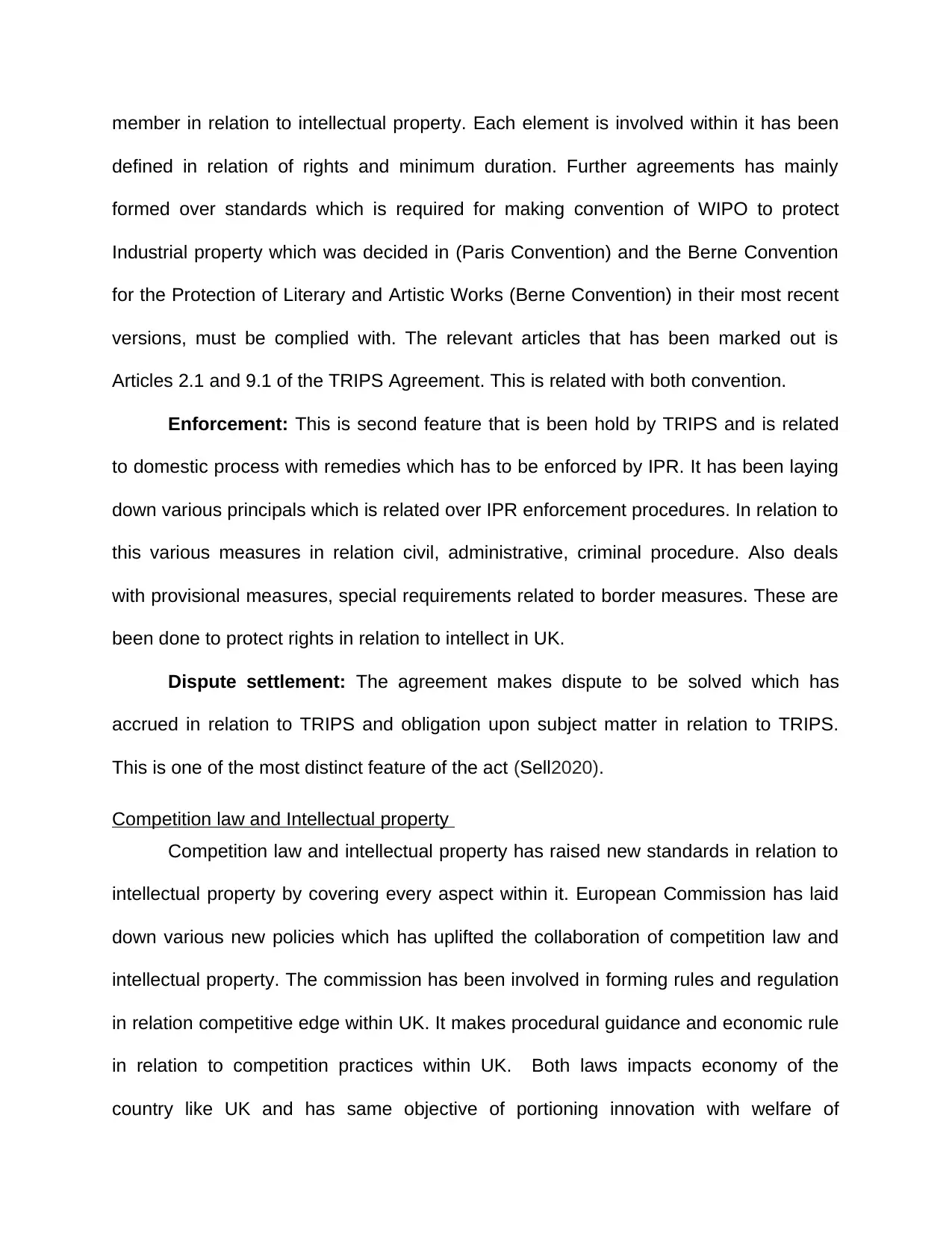
member in relation to intellectual property. Each element is involved within it has been
defined in relation of rights and minimum duration. Further agreements has mainly
formed over standards which is required for making convention of WIPO to protect
Industrial property which was decided in (Paris Convention) and the Berne Convention
for the Protection of Literary and Artistic Works (Berne Convention) in their most recent
versions, must be complied with. The relevant articles that has been marked out is
Articles 2.1 and 9.1 of the TRIPS Agreement. This is related with both convention.
Enforcement: This is second feature that is been hold by TRIPS and is related
to domestic process with remedies which has to be enforced by IPR. It has been laying
down various principals which is related over IPR enforcement procedures. In relation to
this various measures in relation civil, administrative, criminal procedure. Also deals
with provisional measures, special requirements related to border measures. These are
been done to protect rights in relation to intellect in UK.
Dispute settlement: The agreement makes dispute to be solved which has
accrued in relation to TRIPS and obligation upon subject matter in relation to TRIPS.
This is one of the most distinct feature of the act (Sell2020).
Competition law and Intellectual property
Competition law and intellectual property has raised new standards in relation to
intellectual property by covering every aspect within it. European Commission has laid
down various new policies which has uplifted the collaboration of competition law and
intellectual property. The commission has been involved in forming rules and regulation
in relation competitive edge within UK. It makes procedural guidance and economic rule
in relation to competition practices within UK. Both laws impacts economy of the
country like UK and has same objective of portioning innovation with welfare of
defined in relation of rights and minimum duration. Further agreements has mainly
formed over standards which is required for making convention of WIPO to protect
Industrial property which was decided in (Paris Convention) and the Berne Convention
for the Protection of Literary and Artistic Works (Berne Convention) in their most recent
versions, must be complied with. The relevant articles that has been marked out is
Articles 2.1 and 9.1 of the TRIPS Agreement. This is related with both convention.
Enforcement: This is second feature that is been hold by TRIPS and is related
to domestic process with remedies which has to be enforced by IPR. It has been laying
down various principals which is related over IPR enforcement procedures. In relation to
this various measures in relation civil, administrative, criminal procedure. Also deals
with provisional measures, special requirements related to border measures. These are
been done to protect rights in relation to intellect in UK.
Dispute settlement: The agreement makes dispute to be solved which has
accrued in relation to TRIPS and obligation upon subject matter in relation to TRIPS.
This is one of the most distinct feature of the act (Sell2020).
Competition law and Intellectual property
Competition law and intellectual property has raised new standards in relation to
intellectual property by covering every aspect within it. European Commission has laid
down various new policies which has uplifted the collaboration of competition law and
intellectual property. The commission has been involved in forming rules and regulation
in relation competitive edge within UK. It makes procedural guidance and economic rule
in relation to competition practices within UK. Both laws impacts economy of the
country like UK and has same objective of portioning innovation with welfare of
⊘ This is a preview!⊘
Do you want full access?
Subscribe today to unlock all pages.

Trusted by 1+ million students worldwide
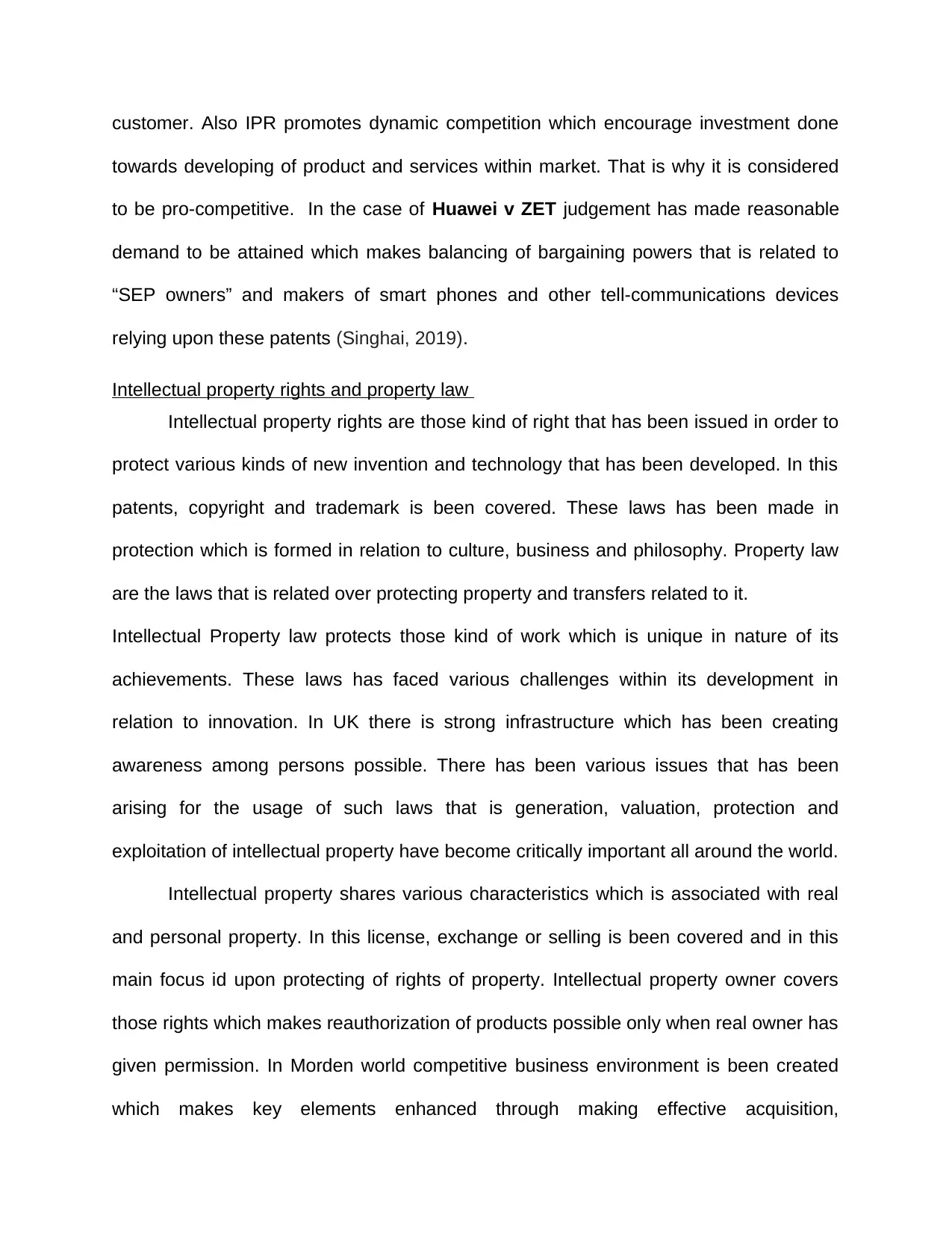
customer. Also IPR promotes dynamic competition which encourage investment done
towards developing of product and services within market. That is why it is considered
to be pro-competitive. In the case of Huawei v ZET judgement has made reasonable
demand to be attained which makes balancing of bargaining powers that is related to
“SEP owners” and makers of smart phones and other tell-communications devices
relying upon these patents (Singhai, 2019).
Intellectual property rights and property law
Intellectual property rights are those kind of right that has been issued in order to
protect various kinds of new invention and technology that has been developed. In this
patents, copyright and trademark is been covered. These laws has been made in
protection which is formed in relation to culture, business and philosophy. Property law
are the laws that is related over protecting property and transfers related to it.
Intellectual Property law protects those kind of work which is unique in nature of its
achievements. These laws has faced various challenges within its development in
relation to innovation. In UK there is strong infrastructure which has been creating
awareness among persons possible. There has been various issues that has been
arising for the usage of such laws that is generation, valuation, protection and
exploitation of intellectual property have become critically important all around the world.
Intellectual property shares various characteristics which is associated with real
and personal property. In this license, exchange or selling is been covered and in this
main focus id upon protecting of rights of property. Intellectual property owner covers
those rights which makes reauthorization of products possible only when real owner has
given permission. In Morden world competitive business environment is been created
which makes key elements enhanced through making effective acquisition,
towards developing of product and services within market. That is why it is considered
to be pro-competitive. In the case of Huawei v ZET judgement has made reasonable
demand to be attained which makes balancing of bargaining powers that is related to
“SEP owners” and makers of smart phones and other tell-communications devices
relying upon these patents (Singhai, 2019).
Intellectual property rights and property law
Intellectual property rights are those kind of right that has been issued in order to
protect various kinds of new invention and technology that has been developed. In this
patents, copyright and trademark is been covered. These laws has been made in
protection which is formed in relation to culture, business and philosophy. Property law
are the laws that is related over protecting property and transfers related to it.
Intellectual Property law protects those kind of work which is unique in nature of its
achievements. These laws has faced various challenges within its development in
relation to innovation. In UK there is strong infrastructure which has been creating
awareness among persons possible. There has been various issues that has been
arising for the usage of such laws that is generation, valuation, protection and
exploitation of intellectual property have become critically important all around the world.
Intellectual property shares various characteristics which is associated with real
and personal property. In this license, exchange or selling is been covered and in this
main focus id upon protecting of rights of property. Intellectual property owner covers
those rights which makes reauthorization of products possible only when real owner has
given permission. In Morden world competitive business environment is been created
which makes key elements enhanced through making effective acquisition,
Paraphrase This Document
Need a fresh take? Get an instant paraphrase of this document with our AI Paraphraser
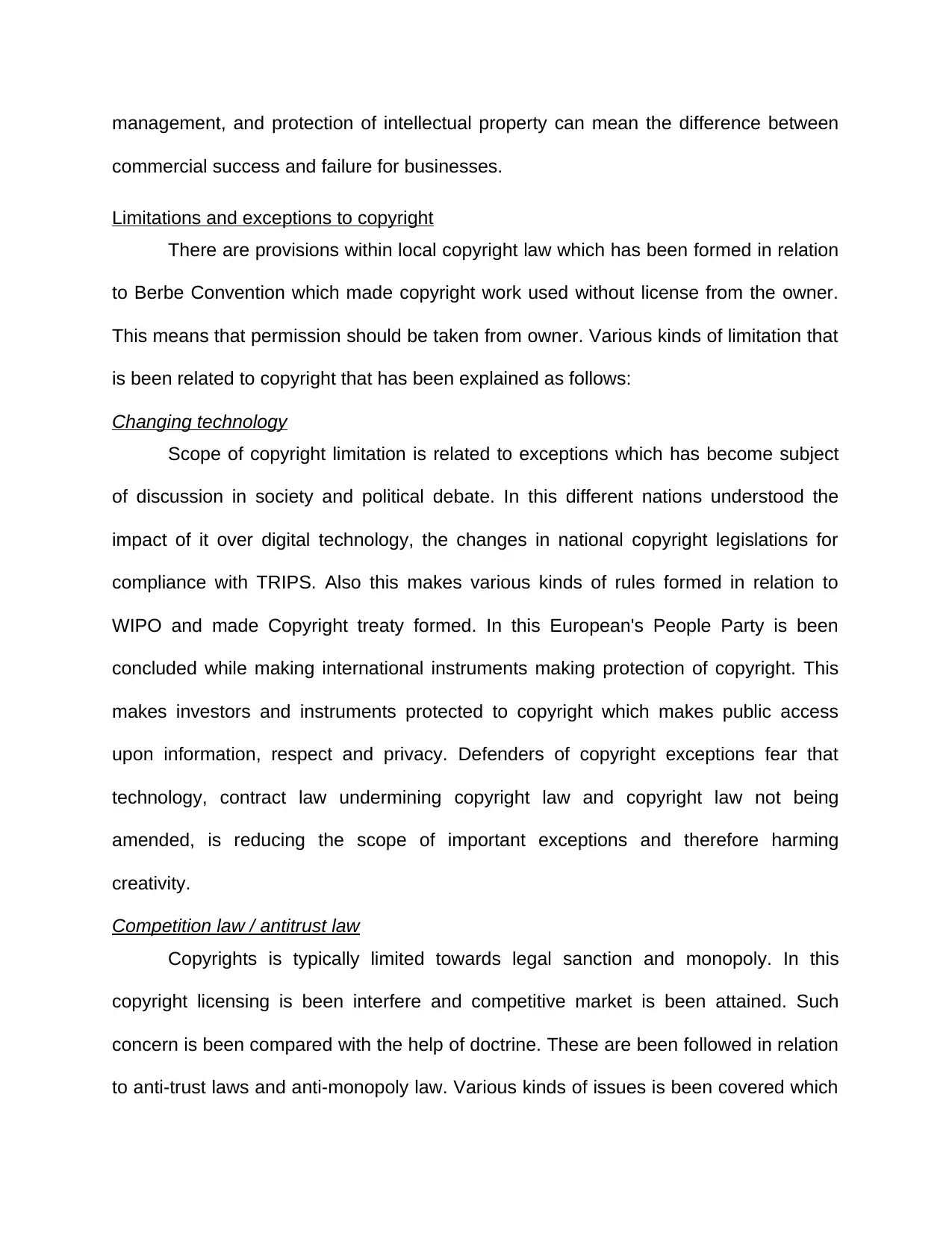
management, and protection of intellectual property can mean the difference between
commercial success and failure for businesses.
Limitations and exceptions to copyright
There are provisions within local copyright law which has been formed in relation
to Berbe Convention which made copyright work used without license from the owner.
This means that permission should be taken from owner. Various kinds of limitation that
is been related to copyright that has been explained as follows:
Changing technology
Scope of copyright limitation is related to exceptions which has become subject
of discussion in society and political debate. In this different nations understood the
impact of it over digital technology, the changes in national copyright legislations for
compliance with TRIPS. Also this makes various kinds of rules formed in relation to
WIPO and made Copyright treaty formed. In this European's People Party is been
concluded while making international instruments making protection of copyright. This
makes investors and instruments protected to copyright which makes public access
upon information, respect and privacy. Defenders of copyright exceptions fear that
technology, contract law undermining copyright law and copyright law not being
amended, is reducing the scope of important exceptions and therefore harming
creativity.
Competition law / antitrust law
Copyrights is typically limited towards legal sanction and monopoly. In this
copyright licensing is been interfere and competitive market is been attained. Such
concern is been compared with the help of doctrine. These are been followed in relation
to anti-trust laws and anti-monopoly law. Various kinds of issues is been covered which
commercial success and failure for businesses.
Limitations and exceptions to copyright
There are provisions within local copyright law which has been formed in relation
to Berbe Convention which made copyright work used without license from the owner.
This means that permission should be taken from owner. Various kinds of limitation that
is been related to copyright that has been explained as follows:
Changing technology
Scope of copyright limitation is related to exceptions which has become subject
of discussion in society and political debate. In this different nations understood the
impact of it over digital technology, the changes in national copyright legislations for
compliance with TRIPS. Also this makes various kinds of rules formed in relation to
WIPO and made Copyright treaty formed. In this European's People Party is been
concluded while making international instruments making protection of copyright. This
makes investors and instruments protected to copyright which makes public access
upon information, respect and privacy. Defenders of copyright exceptions fear that
technology, contract law undermining copyright law and copyright law not being
amended, is reducing the scope of important exceptions and therefore harming
creativity.
Competition law / antitrust law
Copyrights is typically limited towards legal sanction and monopoly. In this
copyright licensing is been interfere and competitive market is been attained. Such
concern is been compared with the help of doctrine. These are been followed in relation
to anti-trust laws and anti-monopoly law. Various kinds of issues is been covered which
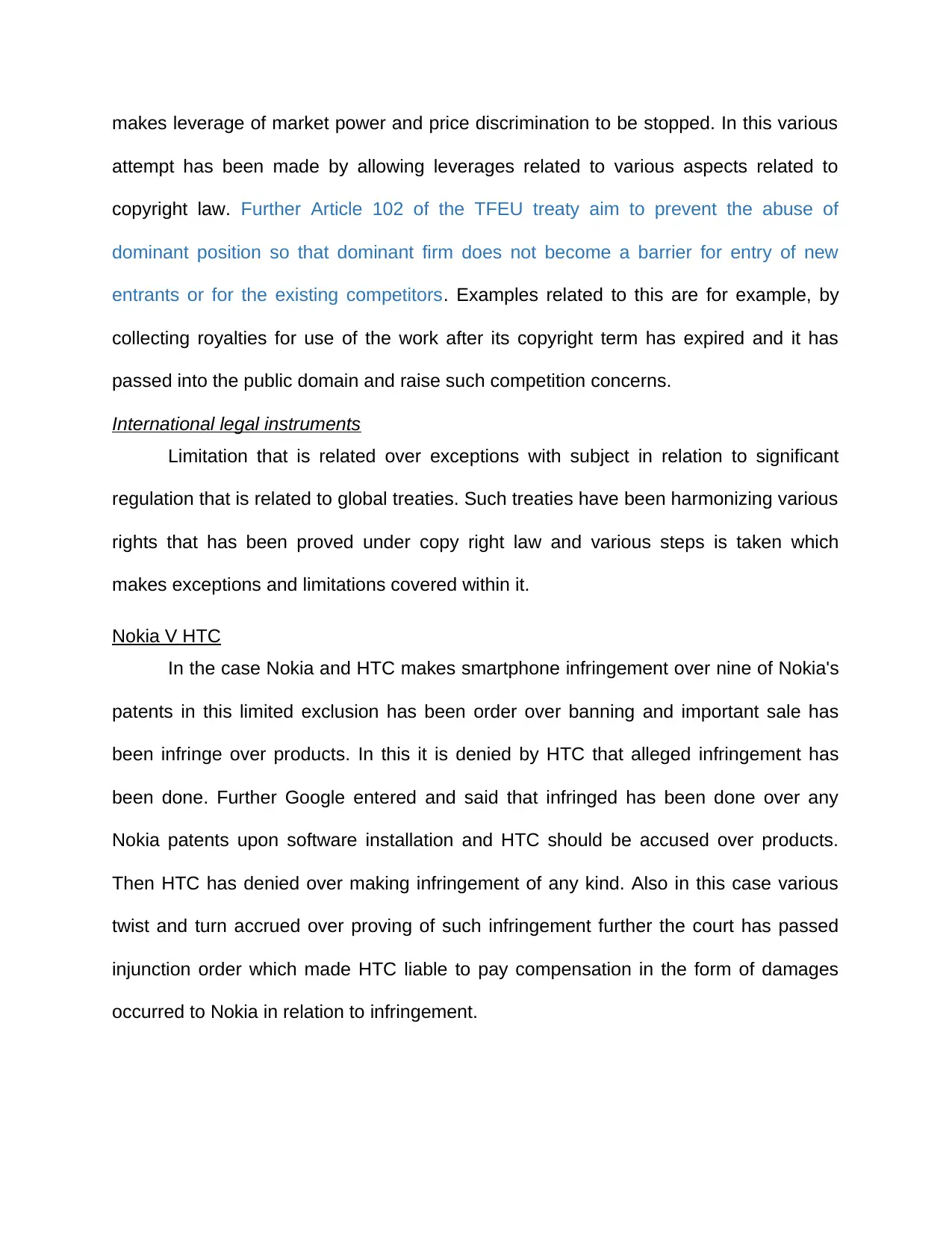
makes leverage of market power and price discrimination to be stopped. In this various
attempt has been made by allowing leverages related to various aspects related to
copyright law. Further Article 102 of the TFEU treaty aim to prevent the abuse of
dominant position so that dominant firm does not become a barrier for entry of new
entrants or for the existing competitors. Examples related to this are for example, by
collecting royalties for use of the work after its copyright term has expired and it has
passed into the public domain and raise such competition concerns.
International legal instruments
Limitation that is related over exceptions with subject in relation to significant
regulation that is related to global treaties. Such treaties have been harmonizing various
rights that has been proved under copy right law and various steps is taken which
makes exceptions and limitations covered within it.
Nokia V HTC
In the case Nokia and HTC makes smartphone infringement over nine of Nokia's
patents in this limited exclusion has been order over banning and important sale has
been infringe over products. In this it is denied by HTC that alleged infringement has
been done. Further Google entered and said that infringed has been done over any
Nokia patents upon software installation and HTC should be accused over products.
Then HTC has denied over making infringement of any kind. Also in this case various
twist and turn accrued over proving of such infringement further the court has passed
injunction order which made HTC liable to pay compensation in the form of damages
occurred to Nokia in relation to infringement.
attempt has been made by allowing leverages related to various aspects related to
copyright law. Further Article 102 of the TFEU treaty aim to prevent the abuse of
dominant position so that dominant firm does not become a barrier for entry of new
entrants or for the existing competitors. Examples related to this are for example, by
collecting royalties for use of the work after its copyright term has expired and it has
passed into the public domain and raise such competition concerns.
International legal instruments
Limitation that is related over exceptions with subject in relation to significant
regulation that is related to global treaties. Such treaties have been harmonizing various
rights that has been proved under copy right law and various steps is taken which
makes exceptions and limitations covered within it.
Nokia V HTC
In the case Nokia and HTC makes smartphone infringement over nine of Nokia's
patents in this limited exclusion has been order over banning and important sale has
been infringe over products. In this it is denied by HTC that alleged infringement has
been done. Further Google entered and said that infringed has been done over any
Nokia patents upon software installation and HTC should be accused over products.
Then HTC has denied over making infringement of any kind. Also in this case various
twist and turn accrued over proving of such infringement further the court has passed
injunction order which made HTC liable to pay compensation in the form of damages
occurred to Nokia in relation to infringement.
⊘ This is a preview!⊘
Do you want full access?
Subscribe today to unlock all pages.

Trusted by 1+ million students worldwide
1 out of 18
Related Documents
Your All-in-One AI-Powered Toolkit for Academic Success.
+13062052269
info@desklib.com
Available 24*7 on WhatsApp / Email
![[object Object]](/_next/static/media/star-bottom.7253800d.svg)
Unlock your academic potential
Copyright © 2020–2025 A2Z Services. All Rights Reserved. Developed and managed by ZUCOL.





